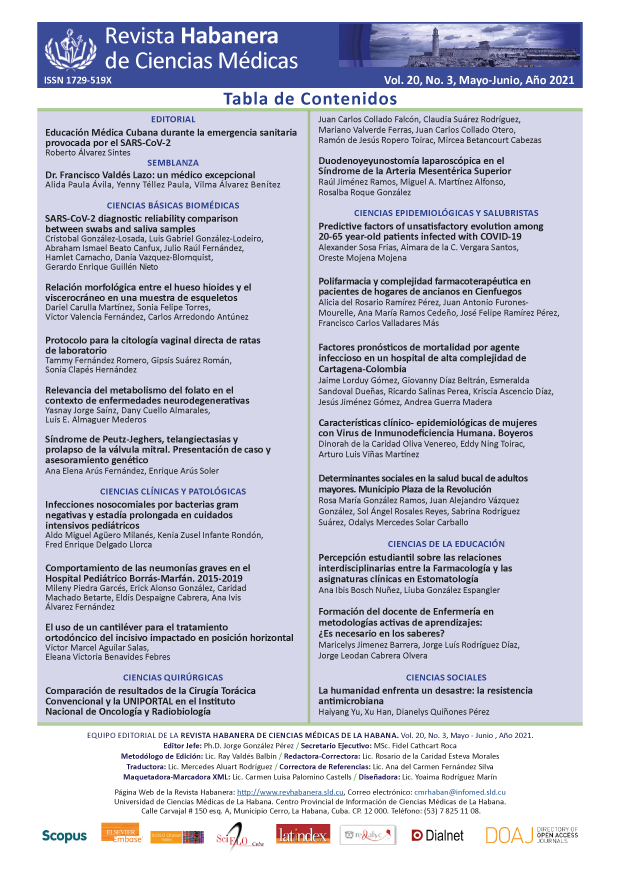Comparison between nasopharyngeal swabs and saliva as reliable specimens for the diagnosis of SARS-CoV-2
Keywords:
Saliva, Covid-19, SARS-CoV-2, sensibility, RT-PCR, nasopharyngeal swab, oropharyngeal swabAbstract
Introduction: The SARS-CoV-2 virus is a positive-strand RNA virus. The virus can also be detected in many different specimens as throat swabs, nasal swabs, sputum, saliva, blood, etc.
Objective: The aim of this paper is to compare the reliability of different types of specimen collection, saliva and swabs samples for the detection of SARS-CoV-2.
Material and Methods: A sample of 22 COVID-19 positive patients was selected. Paired samples from saliva, nasopharyngeal, oropharyngeal and nasopharyngeal + oropharyngeal swabs were collected on the 7th day after diagnosis. The hyssops and medium employed was IMPROSWAB and IMPROVIRAL NAT Medium, Germany. The sample evaluation was conducted through RT-PCR. The results were compared using Fisher’s exact test and ROC curve. The gold standard proposed in this paper was the nasopharyngeal + oropharyngeal swabs specimen.
Results: The gold standard method detected 10 true positive cases, of which oropharyngeal swabs, nasopharyngeal swabs and saliva only detected three positive cases. Significant differences (Fisher’s exact test p = 0.003) were detected in the comparison between saliva and the gold standart proposed. The ROC curve analysis showed that saliva had an area under the curve of 0.650, with a 30% of sensibility. However, the nasopharyngeal and nasopharyngeal + oropharyngeal samples had an area under curve of 0.950 and 1.000, respectively, with a sensibility of 90% and 100%, respectively.
Conclusion: Saliva samples are not a reliable specimen for SARS-CoV-2 RNA detection. In turn, the most reliable specimens are nasopharyngeal and nasopharyngeal + oropharyngeal samples collected by swabbing.
Downloads
References
1. Wu F, Zhao S, Yu B. A new coronavirus associated with human respiratory disease in China. Nature [Internet]. 2020 [Cited 27/08/2020];579:265-9. Available in: https://doi.org/10.1038/s41586-020-2008-3
2. Seema Singh. COVID-19: A Deadly Virus. IJMSCR [Internet]. 2020 [Cited 27/08/2020];2(2):1-5. Available in: https://www.journalofmedical.com/archives/2020.v2.i2.30
3. World Health Organization. Coronavirus disease 2019 (COVID-19) [Internet]. Geneva: World Health Organization; 2020 [Cited 27/08/2020]. Available in: https://www.covid19.who.int
4. Wang D, Hu B, Hu C, Zhu F, Liu X, Zhang J, et al. Clinical characteristics of 138 hospitalized patients with 2019 novel coronavirus-infected pneumonia in Wuhan, China. JAMA [Internet]. 2020 [Cited 27/08/2020];323(11):1061-9. Available in: http://doi.org/10.1001/jama.2020.1585
5. Péré H, Podglajen I, Wack M, Flamarion E, Mirault T, Goudot G, et al. Nasal swab sampling for SARS-CoV-2: a convenient alternative in times of nasopharyngeal swab shortage. J Clin Microbiol [Internet]. 2020 [Cited 27/08/2020];58:e00721-20. Available in: http://doi.org/10.1128/JCM.00721-20
6. Tang YW, Schmitz JE, Persing DH, Stratton CW. Laboratory diagnosis of COVID-19: current issues and challenges. J Clin Microbiol [Internet]. 2020 [Cited 27/08/2020];(58):e00512-20. Available in: https://doi.org/10.1128/JCM.00512-20
7. Loeffelholz MJ, Tang YW. Laboratory diagnosis of emerging human coronavirus infections - the state of the art. Emerg Microbes Infect [Internet]. 2020 [Cited 27/08/2020];9(1):747-56. Available in: http://doi.org/10.1080/22221751.2020.1745095
8. Pan Y, Zhang D, Yang P, Poon LLM, Wang Q. Viral load of SARS-CoV-2 in clinical samples. Lancet Infect Dis [Internet]. 2020 [Cited 27/08/2020];20:[Aprox. 2p.]. Available in: http://doi.org/10.1016/S1473-3099(20)30113-4
9. Wang W, Xu Y, Gao R, Lu R, Han R, Wu G, et al. Detection of SARS-CoV-2 in Different Types of Clinical Specimens. JAMA [Internet]. 2020 [Cited 27/08/2020];323(18):1843-4. Available in: http://doi.org/10.1001/jama.2020.3786
10. Czumbel LM, Kiss S, Farkas N, Mandel I, Hegyi AE, Nagy AK, et al. Saliva as a Candidate for COVID-19 Diagnostic Testing: A Meta-Analysis [Internet]. 2020 [Cited 27/08/2020];7:465. Available in: http://doi.org/10.3389/fmed.2020.00465
11. Melián RA, Calcumil HP, Boin BC, Carrasco SR. Detección de COVID-19 (SARS-CoV-2) mediante la saliva: Una alternativa diagnóstica poco invasiva. Int J Odontostomat [Internet]. 2020 [Cited 27/08/2020];14(3):316-20. Available in: https://dx.doi.org/10.4067/S0718-381X2020000300316
12. Meng, L, Hua F, Bian Z. Coronavirus Disease 2019 (COVID-19): Emerging and Future Challenges for Dental and Oral Medicine. J Dent Res [Internet]. 2020 [Cited 27/08/2020];99(5):481-7. Available in: https://www.doi.org/10.1177/0022034520914246
13. Lan L, Xu D, Ye G, Xia C, Wang S, Li Y, et al. Positive RT-PCR test results in patients recovered from COVID-19. JAMA [Internet]. 2020 [Cited 27/08/2020];323(15):1502-3. Available in: http://doi.org/10.1001/jama.2020.2783
14. Lio T, Gong D, Xiao J, Hu J, He G, Rong Z, et al. Cluster infections play important role in the rapid evolution of COVID-19 trasmission: A systematic review. Int J Infect Dis [Internet]. 2020 [Cited 27/08/2020];99:374-80. Available in: http://doi.org/10.1016/j.ijid2020.07.073
15. World Health Organization. Laboratory Guidelines for Detection and Diagnosis of the Novel Coronavirus (2019-nCov) Infection [Internet]. Geneva: World Health Organization; 2020 [Cited 27/08/2020]. Available in: https://www.paho.org/en/documents/laboratory-guidelines-detection-and-diagnosis-novel-coronavirus-2019-ncov-infection
16. Khurshid Z, Asiri FYI, Wadaani H. Human Saliva: Non-Invasive Fluid for Detecting Novel Coronavirus (2019-nCoV). Int J Environ Res Public Health [Internet]. 2020 [Cited 27/08/2020];17(7):2225. Available in: http://doi.org/10.3390/ijerph17072225
17. Center for Disease Control and Prevention. Interim Guideline for Collecting, Handling, and Testing Clinical Specimens for COVID-19 [Internet]. Atlanta: Center for Disease Control and Prevention; 2020 [Cited 27/08/2020]. Available in: https://www.cdc.gov/coronavirus/2019-ncov/lab/guideline-clinical-specimens.html
18. Iwasaki S, Fujisawa S, Nakakubo S, Kamada K, Yamashita Y, Fukumoto T, et al. Comparison of SARS-CoV-2 detection in nasopharyngeal swab and saliva. J Infect [Internet]. 2020 [Cited 27/08/2020];81(2):e145-7. Available in: http://doi.org/10.1016/j.jinf.2020.05.071
19. Wyllie AL, Fournier J, Casanovas Massana A, Campbell M, Tokuyama M, Vijayakumar P, et al. Saliva is more sensitive for SARS-CoV-2 detection in COVID-19 patients than nasopharyngeal swabs. J Infect [Internet]. 2020 [Cited 27/08/2020];81(2):e148-9. Available in: http://doi.org/10.1016/j.inf.2020.05.071
20. Williams E, Bond K, Zhang B, Putland M, Williamson DA. Saliva as a non-invasive specimen for detection of SARS-CoV-2. J Clin Microbiol [Internet]. 2020 [Cited 27/08/2020];58(8):e00776-20. Available in: http://doi.org/10.1128/JMC.00776-20
21. Becker D, Sandoval E, Amin A. Saliva is less sensitive than nasopharyngeal swabs for COVID-19 detection in the community setting [Internet]. New York: MedRxiv; 2020 [Cited 27/08/2020] Available in: https://doi.org/10.1101/2020.05.11.20092338



